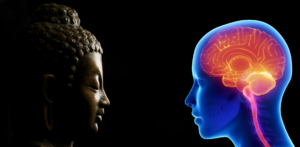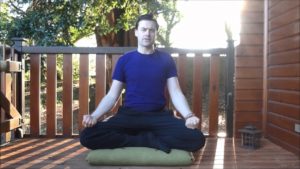Improve Depression, Anxiety, and Stress Symptoms and Lower Rumination with Mindfulness
By John M. de Castro, Ph.D.
“mindfulness-based practices have proved to be helpful in promoting mental well-being, especially by reducing the symptoms of depression and anxiety in various populations.” – Han Ding
Over the last several decades, research and anecdotal experiences have accumulated an impressive evidential case that the development of mindfulness has positive benefits for the individual’s mental, physical, and spiritual life. Mindfulness appears to be beneficial both for healthy people and for people suffering from a myriad of mental and physical illnesses. It appears to be beneficial across ages, from children to the elderly. And it appears to be beneficial across genders, personalities, race, and ethnicity. There is a vast array of techniques for the development of mindfulness that include a variety of forms of meditation, yoga, mindful movements, contemplative prayer, and combinations of practices.
Mindfulness-Based Cognitive Therapy (MBCT) was specifically developed to treat depression. MBCT involves mindfulness training, containing sitting, walking and body scan meditations, and cognitive therapy That is designed to alter how the patient relates to the thought processes that often underlie and exacerbate psychological symptoms. Another therapeutic technique is Compassion Focused Therapy (CFT). “It seeks to help individuals develop compassion for self and others . . . and includes cultivating mindfulness and body awareness. . . . MBCT puts the primary focus on cultivating mindfulness whereas CFT puts it on cultivating compassion toward self and others.”
In today’s Research News article “Effects of Mindfulness Based Cognitive Therapy (MBCT) and Compassion Focused Therapy (CFT) on Symptom Change, Mindfulness, Self-Compassion, and Rumination in Clients With Depression, Anxiety, and Stress.” (See summary below or view the full text of the study at: https://www.frontiersin.org/articles/10.3389/fpsyg.2019.01099/full?utm_source=F-AAE&utm_medium=EMLF&utm_campaign=MRK_999212_69_Psycho_20190528_arts_A), Frostadottir and colleagues recruited patients at a 4-week inpatient rehab clinic who were suffering from mild to moderate depression, anxiety, or stress symptoms. They were assigned to receive twice a week 2 hour sessions for 4 weeks of either Mindfulness-Based Cognitive Therapy (MBCT), Compassion Focused Therapy (CFT), or a wait-list control condition. They were measured before and after treatment and one month later for mindfulness, self-compassion, rumination, anxiety, depression, and stress.
They found that in comparison to baseline and the wait-list control group, the groups that received either Mindfulness-Based Cognitive Therapy (MBCT) or Compassion Focused Therapy (CFT) demonstrated significantly lower levels of rumination, anxiety, depression, and stress and significantly higher levels of mindfulness and self-compassion. These improvements were still present and significant at the 1-month follow-up. Those participants who were high in rumination had significantly higher posttreatment mindfulness for the MBCT group while CFT produced higher mindfulness regardless of rumination.
Since there wasn’t an active control group placebo effects and experimenter bias are possible alternative explanations for the changes. Other research however has routinely demonstrated that mindfulness training produces lower levels of anxiety, depression, stress symptoms, and rumination and higher levels of self-compassion and mindfulness. Hence, it is likely that the benefits seen in the present study were due to the interventions and not to artifact.
The results suggest that both Mindfulness-Based Cognitive Therapy (MBCT) and Compassion Focused Therapy (CFT) are beneficial for the mental health of patients with mild to moderate depression, anxiety, or stress symptoms. Since, both therapies train mindfulness and both successfully increased mindfulness, it would appear that mindfulness training in general is beneficial to patients with mild to moderate mental health issues. So, the present study adds to the large literature demonstrating the benefits of mindfulness for psychological health.
So, improve depression, anxiety, and stress symptoms and lower rumination with mindfulness.
“If you have unproductive worries. You might think ‘I’m late, I might lose my job if I don’t get there on time, and it will be a disaster!’ Mindfulness teaches you to recognize, ‘Oh, there’s that thought again. I’ve been here before. But it’s just that—a thought, and not a part of my core self,’” – Elizabeth Hoge
CMCS – Center for Mindfulness and Contemplative Studies
This and other Contemplative Studies posts are also available on Google+ https://plus.google.com/106784388191201299496/posts and on Twitter @MindfulResearch
Study Summary
Frostadottir AD and Dorjee D (2019) Effects of Mindfulness Based Cognitive Therapy (MBCT) and Compassion Focused Therapy (CFT) on Symptom Change, Mindfulness, Self-Compassion, and Rumination in Clients With Depression, Anxiety, and Stress. Front. Psychol. 10:1099. doi: 10.3389/fpsyg.2019.01099
Objectives: Over the past decade there has been an increasing interest in exploring self-compassion as a related and complementary construct to mindfulness. Increases in self-compassion may predict clinical outcomes after MBCT and cultivation of compassion toward self and others is central to CFT. This pilot study compared the impact of MBCT applying implicit self-compassion instructions and CFT employing explicit self-compassion instructions on symptom change, mindfulness, self-compassion, and rumination.
Method: This non-randomized wait-list controlled study (N = 58) with two intervention arms (MBCT N = 20, CFT N = 18, Control N = 20) assessed the outcomes of clients with depression, anxiety, and stress symptoms from before to after the interventions and at one month follow up (MBCT N = 17, CFT N = 13, Control N = 13).
Results: Both treatments resulted in significant increases in mindfulness and self-compassion and decreases in rumination, depression, anxiety, and stress. Furthermore, MBCT enhanced mindfulness for people who were initially high in rumination, whereas CFT enhanced mindfulness across the board.
Conclusion: The findings suggest that both MBCT and CFT, and hence implicit or explicit self-compassion instructions, produce similar clinical outcomes with CFT enhancing mindfulness regardless of client’s rumination level.









